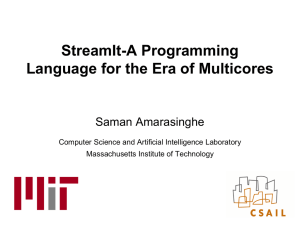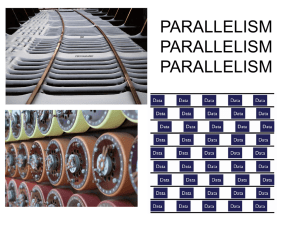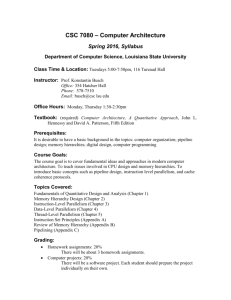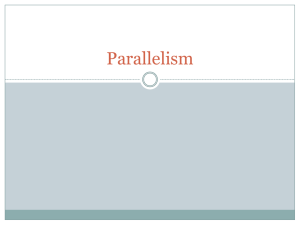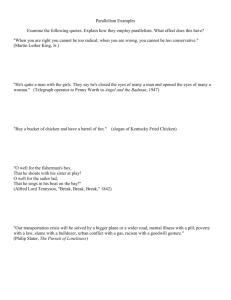MulticoreMenace
advertisement
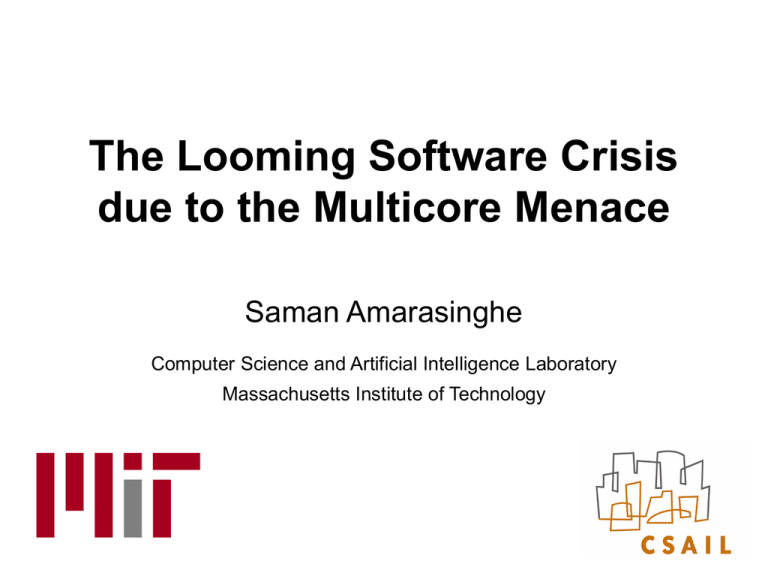
The Looming Software Crisis
due to the Multicore Menace
Saman Amarasinghe
Computer Science and Artificial Intelligence Laboratory
Massachusetts Institute of Technology
The “Software Crisis”
“To put it quite bluntly: as long as there were no
machines, programming was no problem at all;
when we had a few weak computers,
programming became a mild problem, and now
we have gigantic computers, programming has
become an equally gigantic problem."
-- E. Dijkstra, 1972 Turing Award Lecture
2
The First Software Crisis
• Time Frame: ’60s and ’70s
• Problem: Assembly Language Programming
– Computers could handle larger more complex programs
• Needed to get Abstraction and Portability without losing
Performance
3
How Did We Solve the
First Software Crisis?
• High-level languages for von-Neumann machines
– FORTRAN and C
• Provided “common machine language” for uniprocessors
– Only the common properties are exposed
– Hidden properties are backed-up by good compiler technology
Common Properties
Single flow of control
Single memory image
Differences:
Register Allocation
ISA
Instruction Selection
Functional Units
Instruction Scheduling
Register File
4
The Second Software Crisis
• Time Frame: ’80s and ’90s
• Problem: Inability to build and maintain complex and
robust applications requiring multi-million lines of code
developed by hundreds of programmers
– Computers could handle larger more complex programs
• Needed to get Composability, Malleability
and Maintainability
– High-performance was not an issue left to Moore’s Law
5
How Did We Solve the
Second Software Crisis?
• Object Oriented Programming
– C++
– Now C# and Java
• Better tools
– Component libraries, Purify
• Better software engineering methodology
– Design patterns, specification,
testing, code reviews
6
Today: Programmers are
Oblivious about the Processors
• Solid boundary between Hardware and Software
• Programmers don’t have to know anything about the processor
– High level languages abstract away the processors
– Ex: Java bytecode is machine independent
– Moore’s law does not require the programmers to know anything about
the processors to get good speedups
• Programs are oblivious to the processor works on all processors
– A program written in ’70 using C still works and is much faster today
• This abstraction provides a lot of freedom for the programmers
7
The Origins of a Third Crisis
• Time Frame: 2010 to ??
• Problem: Sequential performance is left behind by
Moore’s law
– All software developers have abstracted away the processor
assuming that Moore’s law will always provide performance
gains!
8
The March to Multicore:
Moore’s Law
100000
1,000,000,000
10000
P4
??%/year
100,000,000
P3
1000
52%/year
P2
10,000,000
Pentium
100
486
1,000,000
386
10
8086
1
286
25%/year
Number of Transistors
Performance (vs. VAX-11/780)
From Hennessy and Patterson, Computer Architecture: Itanium 2
A Quantitative Approach, 4th edition, 2006
Itanium
100,000
10,000
1978 1980 1982 1984 1986 1988 1990 1992 1994 1996 1998 2000 2002 2004 2006 2008 2010 2012 2014 2016
9
From David Patterson
The March to Multicore:
Uniprocessor Performance (SPECint)
100000
10000
1,000,000,000
100,000,000
P4
P3
1000
52%/year
P2
10,000,000
Pentium
100
486
1,000,000
386
10
8086
1
286
25%/year
Number of Transistors
Performance (vs. VAX-11/780)
From Hennessy and Patterson, Computer Architecture: Itanium 2
A Quantitative Approach, 4th edition, 2006
Itanium
100,000
10,000
1978 1980 1982 1984 1986 1988 1990 1992 1994 1996 1998 2000 2002 2004 2006 2008 2010 2012 2014 2016
10
From David Patterson
The March to Multicore:
Uniprocessor Performance (SPECint)
100000
1,000,000,000
10000
P4
??%/year
100,000,000
P3
1000
52%/year
P2
10,000,000
Pentium
100
486
1,000,000
386
10
286
25%/year
8086
1
Number of Transistors
Performance (vs. VAX-11/780)
From Hennessy and Patterson, Computer Architecture: Itanium 2
A Quantitative Approach, 4th edition, 2006
Itanium
100,000
10,000
1978 1980 1982 1984 1986 1988 1990 1992 1994 1996 1998 2000 2002 2004 2006 2008 2010 2012 2014 2016
•
General-purpose unicores have stopped historic performance scaling
–
–
–
–
11
Power consumption
Wire delays
DRAM access latency
Diminishing returns of more instruction-level parallelism
From David Patterson
The Origins of a Third Crisis
How to program
multicores?
512
256
Picochip
PC102
Ambric
AM2045
Cisco
CSR-1
Intel
Tflops
128
64
32
# of
cores 16
Raw
Niagara
8
A Program written in the 70’s not only works today…
but also runs faster (tracking Moore’s law)
4
2
1
4004
8080
8086
286
386
486
Pentium
8008
1970
12
Raza
XLR
1975
1980
1985
1990
Broadcom 1480
Cavium
Octeon
Cell
Opteron 4P
Xeon MP
Xbox360
PA-8800 Opteron
Tanglewood
Power4
PExtreme Power6
Yonah
P2 P3 Itanium
P4
Athlon
Itanium 2
1995
2000
2005
20??
The Origins of a Third Crisis
• Time Frame: 2010 to ??
• Problem: Sequential performance is left behind by Moore’s law
• Needed continuous and reasonable performance improvements
– to support new features
– to support larger datasets
• While sustaining portability, malleability and maintainability
without unduly increasing complexity faced by the programmer
critical to keep-up with the current rate of evolution in software
13
Why Parallelism is Hard
• A huge increase in complexity and work for the programmer
– Programmer has to think about performance!
– Parallelism has to be designed in at every level
• Humans are sequential beings
– Deconstructing problems into parallel tasks is hard for many of us
• Parallelism is not easy to implement
– Parallelism cannot be abstracted or layered away
– Code and data has to be restructured in very different (non-intuitive) ways
• Parallel programs are very hard to debug
– Combinatorial explosion of possible execution orderings
– Race condition and deadlock bugs are non-deterministic and illusive
– Non-deterministic bugs go away in lab environment and with
instrumentation
14
Outline: Ideas on Solving
the Third Software Crisis
1. Advances in Computer Architecture
2. Novel Programming Models and Languages
3. Aggressive Compilers
4. Tools to support parallelization, debugging and migration
15
Computer Architecture
• Current generation of multicores
– How can we cobble together something with existing
parts/investments?
– Impact of multicores haven’t hit us yet
• The move to multicore will be a disruptive shift
– An inversion of the cost model
– A forced shift in the programming model
• A chance to redesign the microprocessor from scratch.
• What are the innovations that will reduce/eliminate the
extra burden placed on the programmer?
16
Novel Opportunities in Multicores
• Don’t have to contend with uniprocessors
• Not your same old multiprocessor problem
– How does going from Multiprocessors to Multicores impact
programs?
– What changed?
– Where is the Impact?
– Communication Bandwidth
– Communication Latency
17
Communication Bandwidth
•
How much data can be communicated
between two cores?
•
What changed?
– Number of Wires
– Clock rate
– Multiplexing
•
Impact on programming model?
– Massive data exchange is possible
– Data movement is not the bottleneck
processor affinity not that important
18
10,000X
32 Giga bits/sec
~300 Tera bits/sec
Communication Latency
•
How long does it take for a round trip
communication?
•
What changed?
50X
– Length of wire
– Pipeline stages
•
Impact on programming model?
– Ultra-fast synchronization
– Can run real-time apps
on multiple cores
19
~200 Cycles
~4 cycles
Architectural Innovations
The Raw Experience
Supported by a CISE
Experimental Partnership
The MIT Raw Processor
•
•
Raw project started in 1997
Prototype operational in 2003
The Problem: How to keep the
Moore’s Law going with
– Increasing processor complexity
– Longer wire delays
– Higher power consumption
•
Raw philosophy
– Build a tightly integrated multicore
– Off-load most functions to
compilers and software
•
Raw design
– 16 single issue cores
– 4 register-mapped networks
– Huge IO bandwidth
•
Raw power
–
–
–
–
16 Flops/ops per cycle
16 Memory Accesses per cycle
208 Operand Routes per cycle
12 IO Operations per cycle
180 nm ASIC (IBM SA-27E)
18.2mm x 18.2mm
~100 million transistors
Designed for 225 MHz
Tested at
425 MHz
Raw’s networks are tightly
coupled into the bypass paths
r24
r24
Ex: lb r25, 0x341(r26)
r25
r25
r26
r26
r27
r27
Network
Input
FIFOs
E
M1
A
IF
D
Network
Output
FIFOs
RF
F
fmul r24, r3, r4
M2
TL
P
TV
U
F4
fadd r5, r3, r24
route P->E
route W->P
software
controlled
crossbar
software
controlled
crossbar
WB
Raw Networks is Rarely the Bottleneck
(225 Gb/s @ 225 Mhz)
• Raw has 4 bidirectional,
point-to-point mesh networks
MIPS-Style
Pipeline
– Two of them statically routed
– Two of the dynamically routed
• A single issue core may read
from or write to one network in
a given cycle
8 32-bit
buses
100%
90%
• The cores cannot saturate the
network!
80%
ave. bandwidth utilization
ave. instruction utilization
70%
60%
50%
40%
30%
20%
10%
0%
BitonicSort
FFT
DCT
DES
TDE
Serpent
Outline: Ideas on Solving
the Third Software Crisis
1. Advances in Computer Architecture
2. Novel Programming Models and Languages
3. Aggressive Compilers
4. Tools to support parallelization, debugging and migration
24
Programming Models and
Languages
• Critical to solving the third software crisis
• Novel languages were the central solution in the
last two crises
25
Lessons from the Last Crisis:
The OO Revolution
• Object Oriented revolution did not come out of a vacuum
• Hundreds of small experimental languages
• Rely on lessons learned from lesser-known languages
– C++ grew out of C, Simula, and other languages
– Java grew out of C++, Eiffel, SmallTalk, Objective C, and Cedar/Mesa1
• Depend on results from research community
26
1 J. Gosling, H. McGilton, The Java Language Enviornment
Object Oriented Languages
•
•
•
•
•
•
•
•
•
•
•
•
•
•
•
•
•
•
•
•
•
•
27
Ada 95
BETA
Boo
C++
C#
ColdFusion
Common Lisp
COOL (Object
Oriented COBOL)
CorbaScript
Clarion
Corn
D
Dylan
Eiffel
F-Script
Fortran 2003
Gambas
Graphtalk
IDLscript
incr Tcl
J
JADE
•
•
•
•
•
•
•
•
•
•
•
•
•
•
•
•
•
•
•
•
•
•
•
Java
Lasso
Lava
Lexico
Lingo
Modula-2
Modula-3
Moto
Nemerle
Nuva
NetRexx
Nuva
Oberon (Oberon-1)
Object REXX
Objective-C
Objective Caml
Object Pascal (Delphi)
Oz
Perl 5
PHP
Pliant
PRM
PowerBuilder
•
•
•
•
•
•
•
•
•
•
•
•
•
•
•
•
•
•
•
•
Source: Wikipedia
ABCL
Python
REALbasic
Revolution
Ruby
Scala
Simula
Smalltalk
Self
Squeak
Squirrel
STOOP (Tcl
extension)
Superx++
TADS
Ubercode
Visual Basic
Visual FoxPro
Visual Prolog
Tcl
ZZT-oop
Language Evolution
From FORTRAN to a few present day languages
28
Source: Eric Levenez
Origins of C++
Structural influence
Feature influence
Fortran
1960
Algol 60
CPL
Simula 67
BCPL
1970
C
ML
Algol 68
1980
Clu
C with Classes
Ada
1990
C++
ANSI C
C++arm
C++std
29
Source: B. Stroustrup, The Design and Evolution of C++
Why New Programming Models
and Languages?
• Paradigm shift in architecture
– From sequential to multicore
– Need a new “common machine language”
• New application domains
– Streaming
– Scripting
– Event-driven (real-time)
• New hardware features
– Transactions
– Introspection
– Scalar Operand Networks or Core-to-core DMA
• New customers
– Mobile devices
– The average programmer!
• Can we achieve parallelism without burdening the programmer?
32
Domain Specific Languages
• There is no single programming domain!
– Many programs don’t fit the OO model (ex: scripting and streaming)
• Need to identify new programming models/domains
– Develop domain specific end-to-end systems
– Develop languages, tools, applications a body of knowledge
• Stitching multiple domains together is a hard problem
– A central concept in one domain may not exist in another
– Shared memory is critical for transactions, but not available in streaming
– Need conceptually simple and formally rigorous interfaces
– Need integrated tools
– But critical for many DOD and other applications
33
Programming Languages
and Architectures
C
von-Neumann
machine
• Two choices:
• Bend over backwards to support
old languages like C/C++
• Develop parallel architectures
that are hard to program
34
Modern
architecture
Compiler-Aware
Language Design
The StreamIt Experience
FMDemod
Scatter
LPF1
LPF2
LPF3
Gather
Speaker
Supported by ITR
and NGS Awards
Is there a win-win situation?
boost productivity, enable faster development
and rapid prototyping
programmability
domain specific
optimizations
enable parallel
execution
simple and effective optimizations for
domain specific abstractions
target tiled architectures, clusters, DSPs,
multicores, graphics processors, …
• Some programming models are inherently concurrent
– Coding them using a sequential language is…
• Harder than using the right parallel abstraction
• All information on inherent parallelism is lost
• There are win-win situations
– Increasing the programmer productivity while extracting parallel performance
Streaming Application Abstraction
MPEG bit stream
picture type
VLD
quantization coefficients
macroblocks, motion vectors
<QC>
<PT1, PT2>
splitter
frequency encoded
macroblocks
differentially coded
motion vectors
VLD(QC, PT1, PT2);
• add
Structured
block level diagram
add splitjoin {
split roundrobin(NB,
V);
describes
computation
and flow
ofadddata
pipeline {
add
add
add
add
ZigZag
<QC> IQuantization
Motion Vector Decode
IDCT
Repeat
ZigZag(B);
IQuantization(B) to QC;
IDCT(B);
Saturation(B);
}
• Conceptually
easy to understand
add pipeline {
add MotionVectorDecode();
– Clean
abstraction
of functionality
add Repeat(V,
N);
Saturation
}
spatially encoded macroblocks
motion vectors
join roundrobin(B, V);
joiner
• Mapping to C (sequentialization)
add splitjoin {
split roundrobin(4(B+V),
B+V, B+V);
destroys
this simple
view
}
Y
splitter
Cb
Cr
add MotionCompensation(4(B+V)) to PT1;
for (int i = 0; i < 2; i++) {
add pipeline {
add MotionCompensation(B+V) to PT1;
add ChannelUpsample(B);
}
}
Motion Compensation Motion Compensation Motion Compensation
<PT1> reference
<PT1> reference
<PT1> reference
picture
picture
picture
Channel Upsample
Channel Upsample
joiner
recovered picture
MPEG-2 Decoder
join roundrobin(1, 1, 1);
}
<PT2> Picture Reorder
add PictureReorder(3WH) to PT2;
Color Space Conversion
add ColorSpaceConversion(3WH);
StreamIt Improves Productivity
MPEG bit stream
picture type
VLD
quantization coefficients
macroblocks, motion vectors
<QC>
<PT1, PT2>
splitter
frequency encoded
macroblocks
add VLD(QC, PT1, PT2);
add splitjoin {
split roundrobin(NB, V);
differentially coded
motion vectors
add pipeline {
add ZigZag(B);
add IQuantization(B) to QC;
add IDCT(B);
add Saturation(B);
}
add pipeline {
add MotionVectorDecode();
add Repeat(V, N);
}
ZigZag
<QC> IQuantization
Motion Vector Decode
IDCT
Repeat
Saturation
spatially encoded macroblocks
motion vectors
join roundrobin(B, V);
joiner
}
Y
add splitjoin {
split roundrobin(4(B+V), B+V, B+V);
splitter
Cb
Cr
add MotionCompensation(4(B+V)) to PT1;
for (int i = 0; i < 2; i++) {
add pipeline {
add MotionCompensation(B+V) to PT1;
add ChannelUpsample(B);
}
}
Motion Compensation Motion Compensation Motion Compensation
<PT1> reference
<PT1> reference
<PT1> reference
picture
picture
picture
Channel Upsample
Channel Upsample
joiner
recovered picture
<PT2> Picture Reorder
Color Space Conversion
output to player
join roundrobin(1, 1, 1);
}
add PictureReorder(3WH) to PT2;
add ColorSpaceConversion(3WH);
StreamIt Compiler
Extracts Parallelism
MPEG bit stream
picture type
PT2);
•add VLD(QC,
Task PT1,
Parallelism
VLD
quantization coefficients
macroblocks, motion vectors
<QC>
<PT1, PT2>
add splitjoin {
– Thread (fork/join) parallelism
– Parallelism explicit in algorithm
add pipeline {
– addBetween
ZigZag(B); filters without
add IQuantization(B) to QC;
producer/consumer
relationship
add
IDCT(B);
split roundrobin(NB, V);
splitter
frequency encoded
macroblocks
differentially coded
motion vectors
ZigZag
<QC> IQuantization
Motion Vector Decode
IDCT
Repeat
•
Saturation
spatially encoded macroblocks
motion vectors
joiner
}
Y
Cr
•
– Data parallel loop (forall)
– Between iterations of a stateless filter
join roundrobin(B, V);
– Can’t parallelize filters with state
Channel Upsample
joiner
recovered picture
Pipeline Parallelism
add MotionCompensation(4(B+V)) to PT1;
for (int i = 0; i < 2; i++) {
add pipeline {
add MotionCompensation(B+V) to PT1;
add ChannelUpsample(B);
}
}
– Usually exploited in hardware
– Between producers and consumers
– Stateful filters can be parallelized
Motion Compensation Motion Compensation Motion Compensation
<PT1> reference
<PT1> reference
<PT1> reference
picture
picture
picture
MPEG-2 Decoder
Data Parallelism
add splitjoin {
split roundrobin(4(B+V), B+V, B+V);
splitter
Cb
Channel Upsample
add Saturation(B);
}
add pipeline {
add MotionVectorDecode();
add Repeat(V, N);
}
join roundrobin(1, 1, 1);
}
<PT2> Picture Reorder
add PictureReorder(3WH) to PT2;
Color Space Conversion
add ColorSpaceConversion(3WH);
StreamIt Compiler
Parallelism Processor Resources
•
StreamIt Compilers Finds the Inherent Parallelism
– Graph structure is architecture independent
– Abundance of parallelism in the StreamIt domain
•
Too much parallelism is as bad as too little parallelism
– (remember dataflow!)
•
Map the parallelism in to the available resources in a given multicore
– Use all available parallelism
– Maximize load-balance
– Minimize communication
Benchmarks
m
et
ri
c
M
ea
n
r
nt
k
ad
a
rp
e
R
Se
rb
an
CT
ES
D
D
er
r
rt
de
od
lV
oc
ec
o
So
TD
E
ni
c
Fi
lte
ne
G
2D
ha
n
G
eo
C
M
PE
Bi
to
T
r
ad
io
FF
co
de
FM
R
Vo
Throughput Normalized to Single Core StreamIt
.
StreamIt Performance on Raw
19
18
17
16
15
14
13
12
11
10
9
8
7
6
5
4
3
2
1
0
Outline: Ideas on Solving
the Third Software Crisis
1. Advances in Computer Architecture
2. Novel Programming Models and Languages
3. Aggressive Compilers
4. Tools to support parallelization, debugging and migration
43
Compilers
• Compilers are critical in reducing the burden on
programmers
– Identification of data parallel loops can be easily automated, but
many current systems (Brook, PeakStream) require the
programmer to do it.
• Need to revive the push for automatic parallelization
– Best case: totally automated parallelization hidden from the user
– Worst case: simplify the task of the programmer
44
Parallelizing Compilers
The SUIF Experience
The SUIF Parallelizing Compiler
• The SUIF Project at Stanford in the ’90
–
–
–
–
Mainly FORTRAN
Aggressive transformations to undo “human optimizations”
Interprocedural analysis framework
Scalar and array data-flow, reduction recognition and a host of
other analyses and transformations
• SUIF compiler had the Best SPEC results by automatic
parallelization
• Vector processor
Cray C90
• Uniprocessor
Digital 21164
• SUIF on 8 processors Digital 8400
540
508
1,016
sw m 256
to m c a tv
su2cor
h y d ro 2 d
ear
nasa7
a l v in n
m d ljs p 2
w ave5
m d ljd p 2
o ra
fp p p p
doduc
s p ic e 2 g 6
M FLO PS
8
1000
7
6
800
5
600
4
3
400
2
200
1
0
N u m b e r o f P ro c e s s o rs
SPECFP92 performance
1200
Automatic Parallelization
“Almost” Worked
• Why did not this reach mainstream?
–
–
–
–
–
The compilers were not robust
Clients were impossible (performance at any cost)
Multiprocessor communication was expensive
Had to compete with improvements in sequential performance
The Dogfooding problem
• Today: Programs are even harder to analyze
–
–
–
–
Complex data structures
Complex control flow
Complex build process
Aliasing problem (type unsafe languages)
Outline: Ideas on Solving
the Third Software Crisis
1. Advances in Computer Architecture
2. Novel Programming Models and Languages
3. Aggressive Compilers
4. Tools to support parallelization, debugging and migration
49
Tools
• A lot of progress in tools to improve programmer
productivity
• Need tools to
–
–
–
–
Identify parallelism
Debug parallel code
Update and maintain parallel code
Stitch multiple domains together
• Need an “Eclipse platform for multicores”
50
Migrating the Dusty Deck
• Impossible to bring them to the new era automatically
– Badly mangled, hand-optimized, impossible to analyze code
– Automatic compilation, even with a heroic effort, cannot do anything
• Help rewrite the huge stack of dusty deck
– Application in use
– Source code available
– Programmer long gone
• Getting the new program to have the same behavior is hard
– “Word pagination problem”
• Can take advantage of many recent advances
– Creating test cases
– Extracting invariants
– Failure oblivious computing
51
Facilitate Evaluation and
Feedback for Rapid
Evolution
Language/Compiler/Tools
Idea
Evaluate
Performance
Debugging
Implementation
Evaluation
Functional
Debugging
Evaluation
52
Develop a
Program
Rapid Evaluation
• Extremely hard to get
– Real users have no interest in flaky tools
– Hard to quantify
– Superficial users vs. Deep users will give different feedback
– Fatal flaws as well as amazing uses may not come out immediately
• Need a huge, sophisticated (and expensive) infrastructure
–
–
–
–
–
How to get a lot of application experts to use the system?
How do you get them to become an expert?
How do you get them to use it for a long time?
How do you scientifically evaluate?
How go you get actionable feedback?
• A “Center for Evaluating Multicore Programming Environments”??
53
Build and Mobilize
the Community
• Bring the High Performance Languages/Compilers/Tools folks out of the
woodwork!
– Then: A few customers with the goal of performance at any cost.
– Then: Had to compete with Moore’s law
– Now: Reasonable performance improvements for the masses
• Bring the folks who won the second crisis
– Then: the focus is improving programmer productivity
– Now: how to maintain performance in a multicore world
– Now: If not solved, all the productivity gains will be lost!
• Get architects to listen to language/compiler people
–
–
–
–
54
Then: We don’t need you, we can do everything in hardware
Then: Or here is a cool hardware feature, you figure out how to use it.
Now: Superscalars crashed and burned; cannot keep the status quo!
Now: Need to create a useable programming model
Conclusions
• Programming language research is a critical long-term investment
– In the 1950s, the early background for the Simula language was funded by
the Norwegian Defense Research Establishment
– In 2002, the designers received the ACM Turing Award “for ideas
fundamental to the emergence of object oriented programming.”
• Compilers and Tools are also essential components
• Computer Architecture is at a cross roads
– Once in a lifetime opportunity to redesign from scratch
– How to use the Moore’s law gains to improve the programmability?
• Switching to multicores without losing the gains in programmer
productivity may be the Grandest of the Grand Challenges
– Half a century of work still no winning solution
– Will affect everyone!
• Need a Grand Partnership between the Government, Industry and
Academia to solve this crisis!
55
